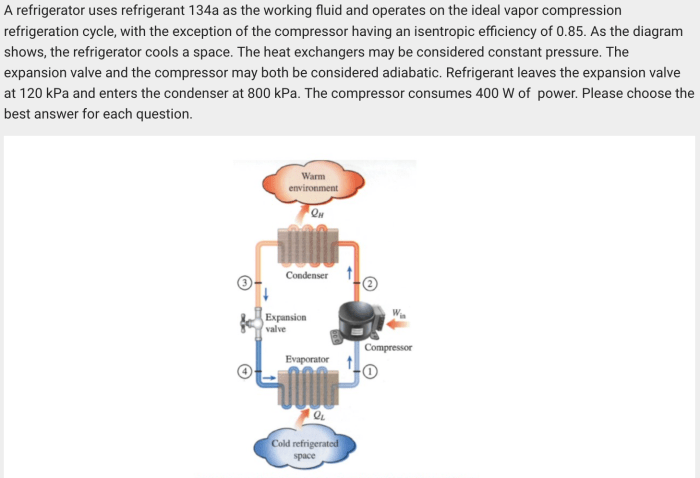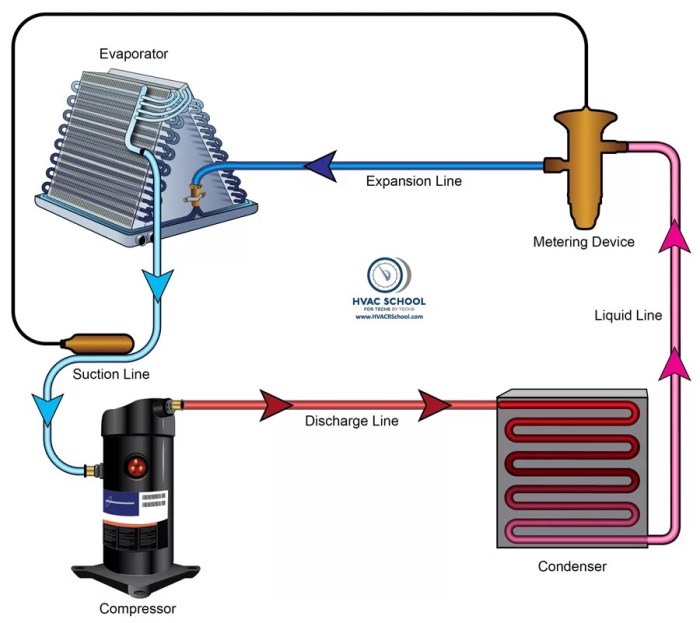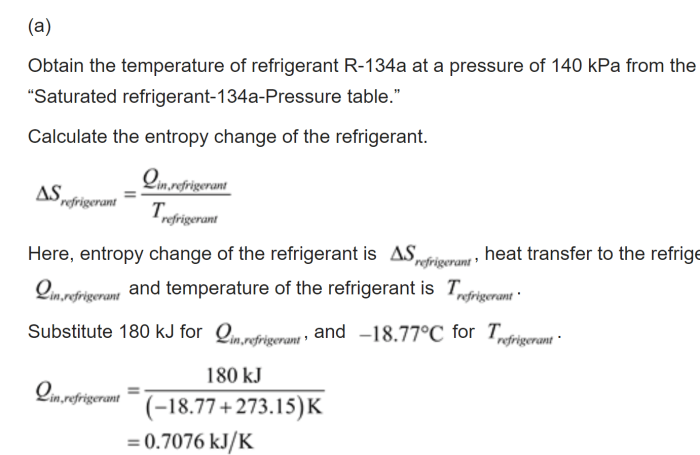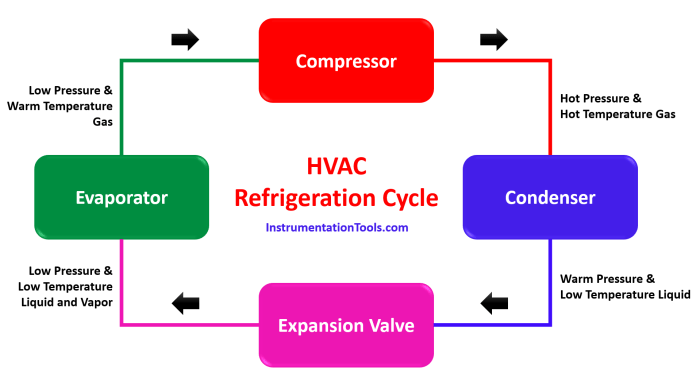Refrigerant 134a enters the evaporator of a refrigeration system, setting the stage for an intricate interplay of thermodynamics and engineering ingenuity. As the lifeblood of this cooling apparatus, refrigerant 134a embarks on a transformative journey, absorbing heat from its surroundings and initiating the refrigeration cycle’s vital energy exchange.
Delving into the evaporator’s design and function, we uncover the intricate dance between refrigerant flow and heat transfer. The evaporator’s serpentine coils, meticulously engineered to maximize surface area, provide an optimal environment for refrigerant 134a to release its thermal energy, paving the way for efficient cooling.
Refrigerant Properties and Characteristics

Refrigerant 134a, also known as 1,1,1,2-tetrafluoroethane, is a hydrofluorocarbon (HFC) refrigerant commonly used in refrigeration and air conditioning systems. It is a colorless, non-flammable gas with a slightly ethereal odor. Refrigerant 134a has a boiling point of -26.1°C (-14.98°F) and a freezing point of -101.1°C
(-149.98°F).
Refrigerant 134a is a relatively stable compound that is not easily broken down by environmental factors. It has a low ozone depletion potential (ODP) of 0 and a global warming potential (GWP) of 1430. However, refrigerant 134a is a greenhouse gas, and its use is being phased out in many countries due to its contribution to climate change.
Role of Refrigerant 134a in the Refrigeration Cycle
In a refrigeration system, refrigerant 134a undergoes a phase change from a liquid to a gas and back again to provide cooling. The refrigerant enters the evaporator as a high-pressure liquid and absorbs heat from the surrounding environment, causing it to evaporate.
The refrigerant then travels to the compressor, where it is compressed and its pressure and temperature increase. The high-pressure, high-temperature refrigerant then travels to the condenser, where it releases heat to the surrounding environment and condenses back into a liquid.
The liquid refrigerant then travels to the expansion valve, where it is expanded and its pressure and temperature decrease. The low-pressure, low-temperature refrigerant then travels back to the evaporator, and the cycle repeats.
Evaporator Function and Design

Function of the Evaporator in the Refrigeration System
The evaporator is a heat exchanger that absorbs heat from the surrounding environment and transfers it to the refrigerant. The evaporator is typically located in the refrigerated space, such as the inside of a refrigerator or freezer. The evaporator is made of a series of tubes or plates that are filled with refrigerant.
As the refrigerant flows through the evaporator, it absorbs heat from the surrounding environment and evaporates. The evaporator is designed to maximize the heat transfer between the refrigerant and the surrounding environment.
Design and Construction of the Evaporator
Evaporators are typically made of copper or aluminum tubes or plates. The tubes or plates are arranged in a way that maximizes the surface area of the evaporator, which increases the heat transfer between the refrigerant and the surrounding environment.
The evaporator is also designed to minimize the pressure drop of the refrigerant as it flows through the evaporator.
Refrigerant Flow and Heat Transfer
Process of Refrigerant 134a Entering the Evaporator
Refrigerant 134a enters the evaporator as a high-pressure liquid. The refrigerant then flows through the evaporator, absorbing heat from the surrounding environment and evaporating. The refrigerant then travels to the compressor, where it is compressed and its pressure and temperature increase.
Heat Transfer between the Refrigerant and the Surrounding Environment
The heat transfer between the refrigerant and the surrounding environment occurs through the evaporator tubes or plates. The refrigerant absorbs heat from the surrounding environment and evaporates. The heat transfer rate is determined by the temperature difference between the refrigerant and the surrounding environment, the surface area of the evaporator, and the flow rate of the refrigerant.
Evaporator Performance and Efficiency

Factors Affecting Evaporator Performance and Efficiency
The performance and efficiency of the evaporator are affected by a number of factors, including:
- The temperature difference between the refrigerant and the surrounding environment
- The surface area of the evaporator
- The flow rate of the refrigerant
- The design of the evaporator
Methods for Optimizing Evaporator Performance, Refrigerant 134a enters the evaporator of a refrigeration system
There are a number of methods that can be used to optimize the performance of the evaporator, including:
- Increasing the surface area of the evaporator
- Increasing the flow rate of the refrigerant
- Improving the design of the evaporator
Refrigerant Management and Control

Importance of Proper Refrigerant Management in the Evaporator
Proper refrigerant management is essential for the efficient and safe operation of the evaporator. If the refrigerant charge is too low, the evaporator will not be able to absorb enough heat from the surrounding environment, and the system will not be able to cool properly.
If the refrigerant charge is too high, the evaporator will be flooded with refrigerant, and the system will not be able to operate efficiently.
Methods for Controlling Refrigerant Flow and Pressure in the Evaporator
There are a number of methods that can be used to control the refrigerant flow and pressure in the evaporator, including:
- Using an expansion valve
- Using a thermostatic expansion valve (TXV)
- Using an electronic expansion valve (EEV)
Environmental Considerations: Refrigerant 134a Enters The Evaporator Of A Refrigeration System
Environmental Impact of Refrigerant 134a
Refrigerant 134a is a greenhouse gas, and its use is being phased out in many countries due to its contribution to climate change. Refrigerant 134a has a global warming potential (GWP) of 1430, which means that it is 1430 times more potent than carbon dioxide in terms of its ability to contribute to climate change.
Regulations and Best Practices for Handling and Disposing of Refrigerant 134a
There are a number of regulations and best practices that should be followed when handling and disposing of refrigerant 134a. These regulations and best practices include:
- Using certified technicians to handle and dispose of refrigerant 134a
- Recovering and recycling refrigerant 134a whenever possible
- Disposing of refrigerant 134a in accordance with local regulations
Question & Answer Hub
What is the primary function of refrigerant 134a in a refrigeration system?
Refrigerant 134a serves as the working fluid, absorbing heat from the environment and releasing it elsewhere, enabling the system’s cooling effect.
How does refrigerant 134a contribute to the refrigeration cycle?
As refrigerant 134a flows through the evaporator, it undergoes a phase change from liquid to gas, absorbing heat from its surroundings. This heat absorption initiates the cooling process.
What factors influence the performance and efficiency of the evaporator?
Factors such as evaporator design, refrigerant flow rate, and operating temperature significantly impact the evaporator’s ability to transfer heat effectively.